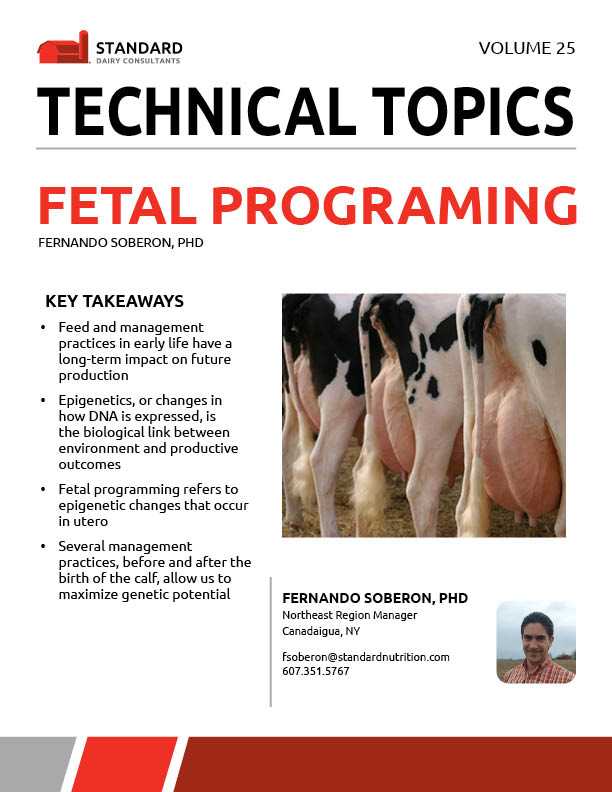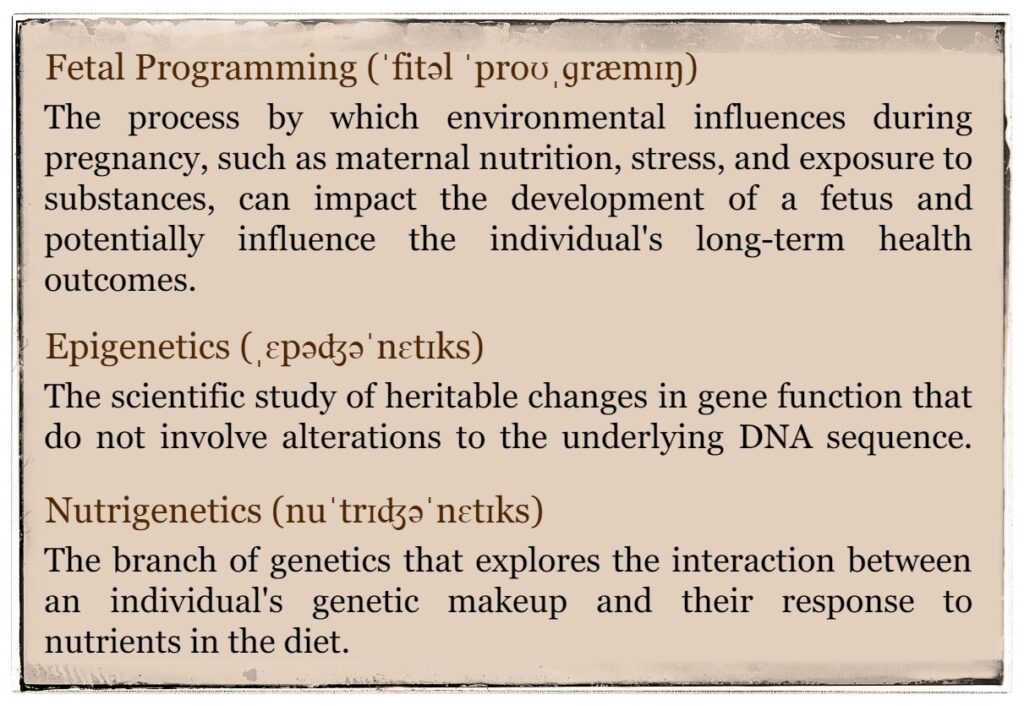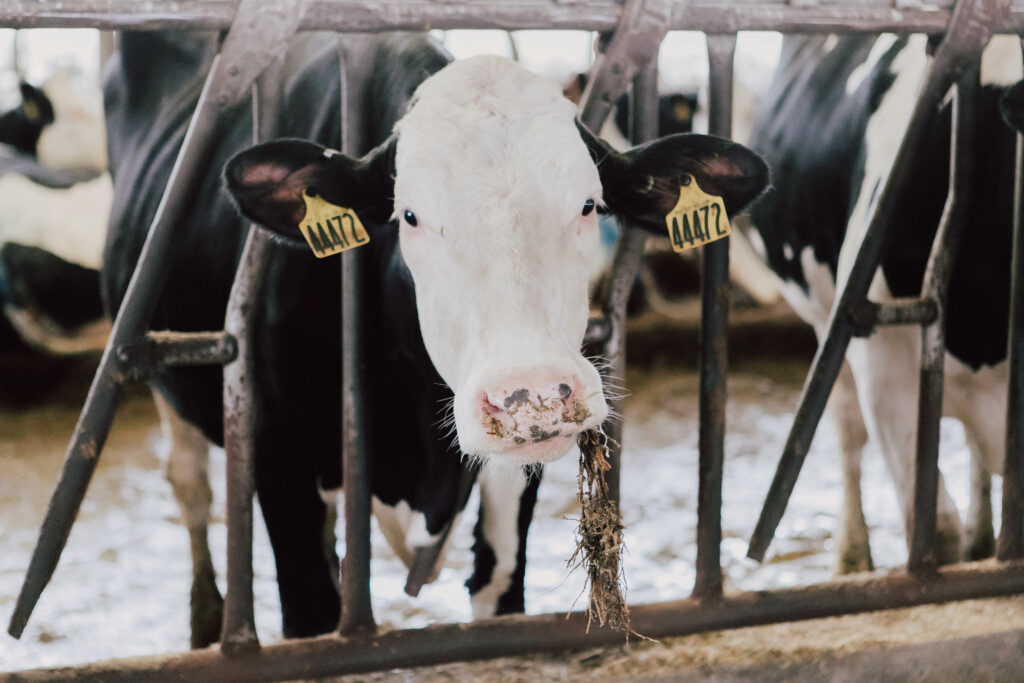Written by: Fernando Soberon, PHD
KEY TAKEAWAYS IN THIS ISSUE OF TECHNICAL TOPICS:
- Feed and management practices in early life have a long-term impact on future production
- Epigenetics, or changes in how DNA is expressed, is the biological link between environment and productive outcomes
- Fetal programming refers to epigenetic changes that occur in utero
- Several management practices, before and after the birth of the calf, allow us to maximize genetic potential

Fetal programming, epigenetics, nutrigenetics! How much potential is there for a dairy? Any dairyman can recognize the value of a good heifer – strong genetic lineage, good udder placement, strong legs, and large thoracic capacity. There is undeniable value in a heifer like that, but we also know that there is more to the story than just parental matching. We have strong evidence that pre-weaning growth rates have a long-term effect on the productivity of dairy heifers, which cannot be explained by heifer size. Fabre et al. demonstrated back in 2005 that the amount of colostrum fed to a calf affected their growth rate, survival rate, and milk production through the end of their second lactation.
EPIGENETICS EXPLAINED

What are the biological mechanisms that control the long-term effects of early life modulations? This is where epigenetics plays a role. Let me move away from dairy cattle for a moment to better explain this effect. If we look at a beehive, all the bees within a colony come from the same parents, and thus have identical genetics. The queen bee lays all the eggs and most of them develop to be worker bees. However, when it is time to expand the colony or replace the queen bee, they select some larvae out of the same pool that all of the other worker bees derive from and they feed them a royal jelly. (For the sake of comparison, let’s think of this as colostrum).

The bees provide up to 10 times more food than what is offered to the other larvae. As a consequence of the feeding of royal jelly and more food, these larvae grow to be 2 times larger than other bees, they will have a life span of 20 times that of worker bees and they are the only bees within the colony that will develop their reproductive organs. This is due to a differentiation in the DNA methylation and acetylation, which can be thought of as tiny, molecular “notes” added to the DNA that influence how the instructions of the genes are followed. These changes result in the variance of their gene expression for life. Another way to understand the regulation of gene expression is to consider that every cell in our body, and likewise, every cell in the cow, contains all of the genetic information available; however, the skin cells have silenced most of the genes and only allow the expression of genes needed by skin cells; similarly, liver cells will silence all genes needed for a skin cell but will translate or maintain active those genes needed for liver processes. In these examples, the silencing of genes is absolute, but the same mechanisms are used to modulate expression, making some genes more reactive or less reactive to the environment in order to increase the likeliness of survival.
Let’s translate this to the offspring. When a cow is pregnant in an environment with plentiful food, the cow’s offspring will need to be bigger and stronger than the rest of its peers to be the one that reproduces. There is no concern for energy efficiency as there is plenty to eat, so the fetal programming directed by the mother will promote faster growth at the expense of energy efficiency. On the other hand, if there is fasting or deprivation during pregnancy, the most efficient offspring will have the best probability of survival, even if they sacrifice size to achieve such efficiency. That programming or gene modulation is done in utero as well as during the first months of life. These gene modulations remain with the calf in many situations for life, even if the original stimulus that created the programming is removed.
PRACTICAL CONSIDERATIONS FOR FETAL PROGRAMMING
What can you do about the fetal programming of your future herd? For starters, there is some evidence that insemination during periods of positive energy balance will not only aid in improving conception but will also have positive regulation in the embryo. Then, further along in the pregnancy, reducing heat stress during the last trimester, which includes both the dry cows and the cows in the close-up period, can have a notable effect on the size, survivability and future milk production of the calf. Researchers in Florida found that calves born to heat-stressed dams absorbed 33% less IgGs than calves born to dams that had been cooled during the dry period. In a succession of three heat-stress studies, these researchers also discovered that calves born to cooled versus heat-stressed dams were 23% larger at birth; later in life, these calves required 0.5 services per pregnancy less than their peers in order to conceive, which consequently reduced their age at first conception by 24 days. During their first lactation, calves from cooled versus heat-stressed dams produced 19% more milk (11 lbs) and were 20% more likely to finish their first lactation. These data affirm the importance of fetal programming during late gestation, as cooling most likely has an effect on the fetus by improving blood flow to the uterus.
EPIGENETICS AND THE CALF
The timing and quantity of colostrum offered is probably the easiest area of opportunity to influence the epigenome of the calf. Without the direct reference to fetal programming, research for many years has consistently shown that calves fed more colostrum have better average daily gains, better conception rates, and increased milk production during first lactation – all of these repercussions go well beyond the protective effect of the initial immunoglobulin increase from the additional feeding of colostrum. We now can better understand it under the epigenetic umbrella. To be more specific, in a study designed to compare the long-term implications of the amount of colostrum fed, Faber et al. observed that calves fed 4 L of colostrum at their first feeding had higher ADGs, higher survival rates throughout the end of second lactation and produced 6% more milk than calves fed 2 L of colostrum at their first feeding. A direct implication of colostrum feeding on the expression of DNA (epigenetics) can be noticed in a study by Bartol et al. in gilts; in this study, Bartol et al. observed a direct effect from the relaxin found in colostrum.
After the relaxin was absorbed by newborn gilts, relaxin-specific receptors in the uterus promoted better development of the uterus and the cervix, correlating with an increased reproductive efficiency later in life. Early-life nutrition, predominantly milk offered during the first month of life, will also have a long-term implication on the calf’s production potential. While many studies have shown better lactational performance due to preweaning nutrition, a meta-analysis provides an easy way to summarize multiple relevant studies. In a meta-analysis published in 2013 by Soberon and Van Amburgh, there was a strong correlation between preweaning growth rate and first lactation milk production, so that for every additional tenth of a pound gained per day preweaning, heifers produced 154 lb more milk in the first lactation. In this analysis, we did not find an upper limit; heifers growing at 0.5 lb more per day preweaning produced 630 lb more milk than their counterparts.
FINAL THOUGHTS
In summary, epigenetic mechanisms, which include fetal programming, help us understand why early life management makes a lifetime impact. It is important to remember to cool dry cows, feed as much colostrum at the first feeding as you can and promote healthy growth rates preweaning through better nutrition. These early investments in heifers will ultimately improve the lifetime performance of the next generation.



